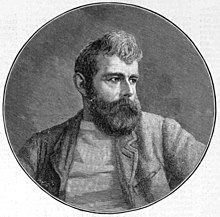William Lionel Wyllie
| William Lionel Wyllie | |
|---|---|

|
|
| Born |
5 July 1851 Camden Town, London |
| Died | 6 April 1931 (aged 79) Primrose Hill, London |
| Nationality | British |
| Education | |
| Known for | Maritime Watercolours and Oils |
| Awards | Turner Gold Medal (1869) |
William Lionel Wyllie (5 July 1851 – 6 April 1931) also known as W L Wyllie was a prolific English painter of maritime themes in both oils and watercolours. He has been described as "the most distinguished marine artist of his day." His work is in the Tate, the Royal Academy, the Imperial War Museum, the National Maritime Museum and many other institutions around the world.
Wyllie was born on 5 July 1851 at 67 Albany Street, Camden, London, the elder son of William Morrison Wyllie (1820–1895), a prosperous minor-genre painter living in London and Wimereux, France. by his wife Katherine Benham (1813–1872), a singer. Before marrying W M Wyllie she had had three children by Percy Clinton Sydney Smythe, 6th Viscount Strangford. One of these, Wyllie's half-brother Lionel Percy Smythe, also made a name for himself as an artist.
Most of Wyllie's early summers were spent in France with his parents. He began to draw from an early age, and his natural talent was encouraged by his father and by Lionel Smythe, his step brother. He was given a thorough artistic education; first at the Heatherley School of Fine Art, and then in 1866, aged 15, at the Royal Academy Schools. At the Royal Academy he studied under Edwin Henry Landseer, John Everett Millais and Frederic Leighton, among others. He further demonstrated his precocious talent when he won the Turner Gold Medal in 1869 at the age of eighteen with Dawn after a Storm. His other early love affair, which he shared with his younger brother and fellow artist Charles William Wyllie, was sailing.
From the early 1870s Wyllie worked as an illustrator of maritime subjects for The Graphic. In 1875 the Academy rejected two of his works, and in anger he declared his intention to give up art for a career at sea. Over the course of several sailing cruises as far afield as Europe he laid the foundations for a lifelong love of the sea and of maritime subjects.
...
Wikipedia
